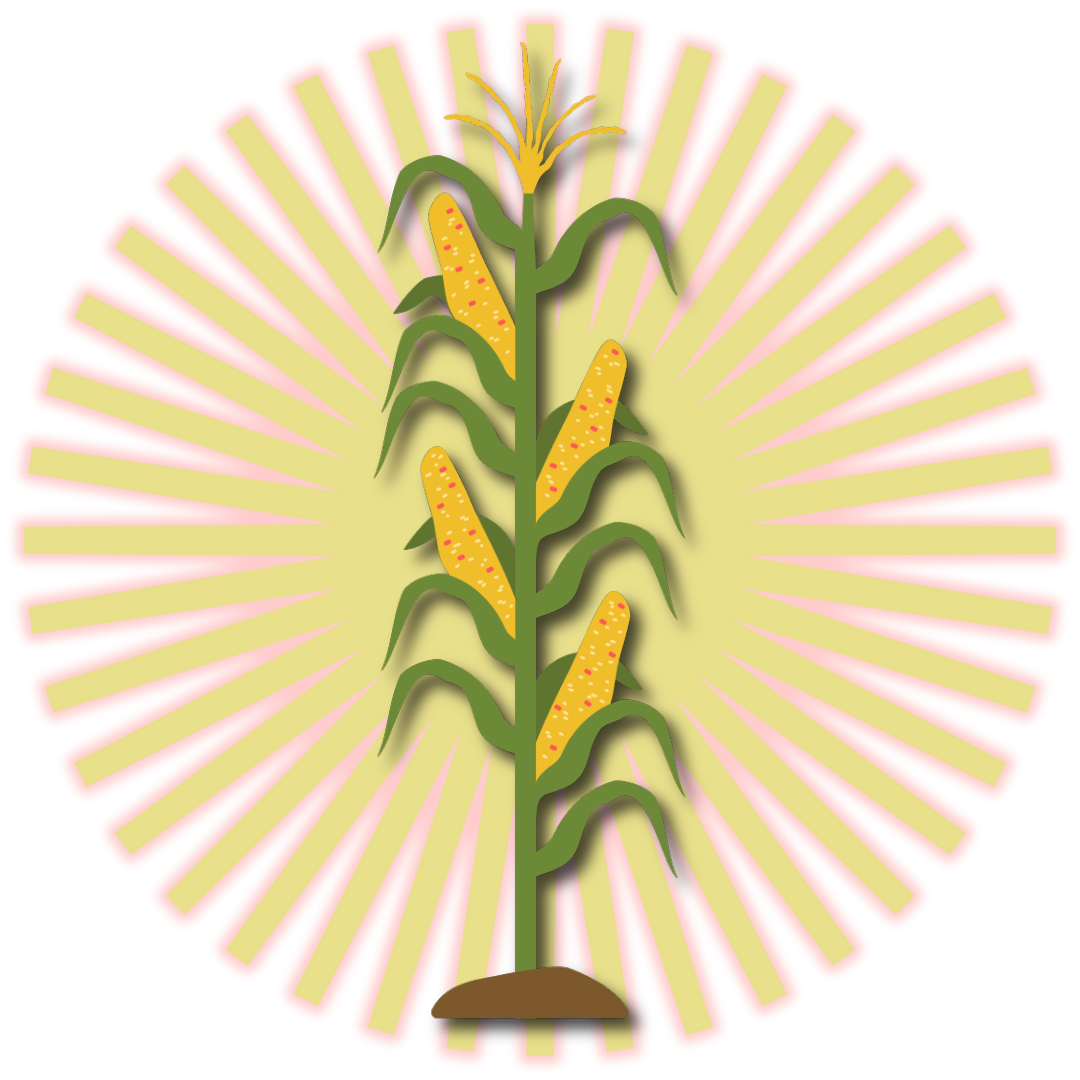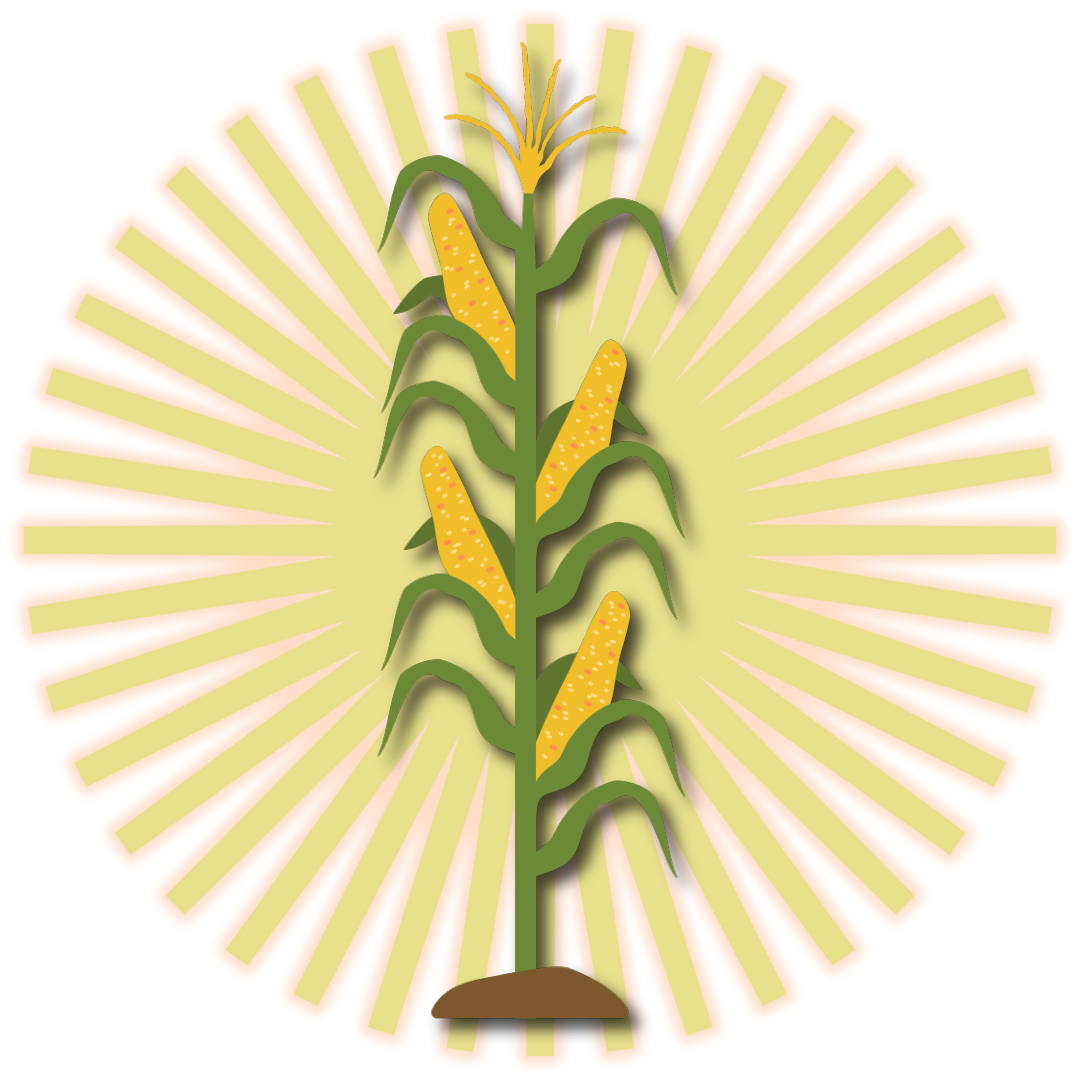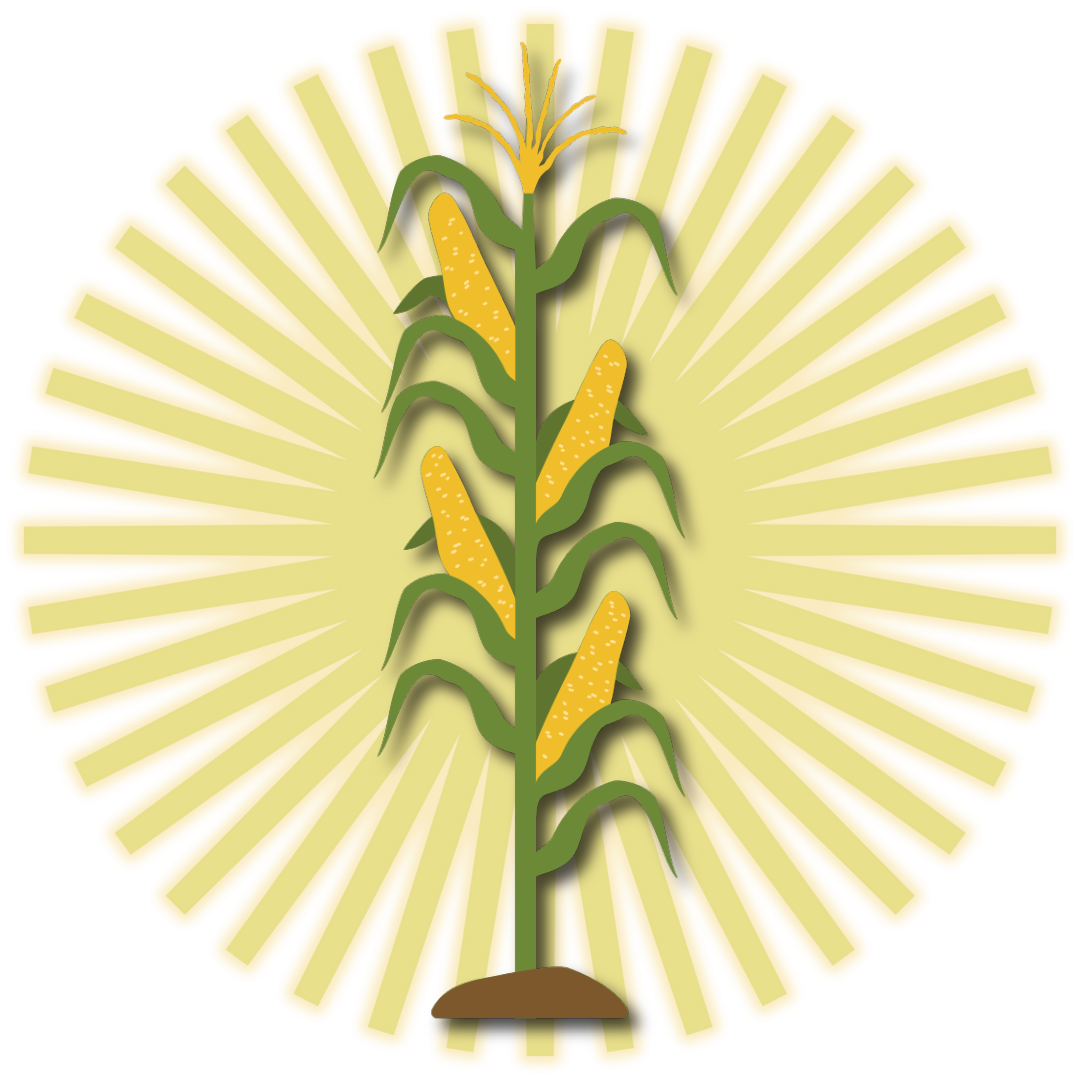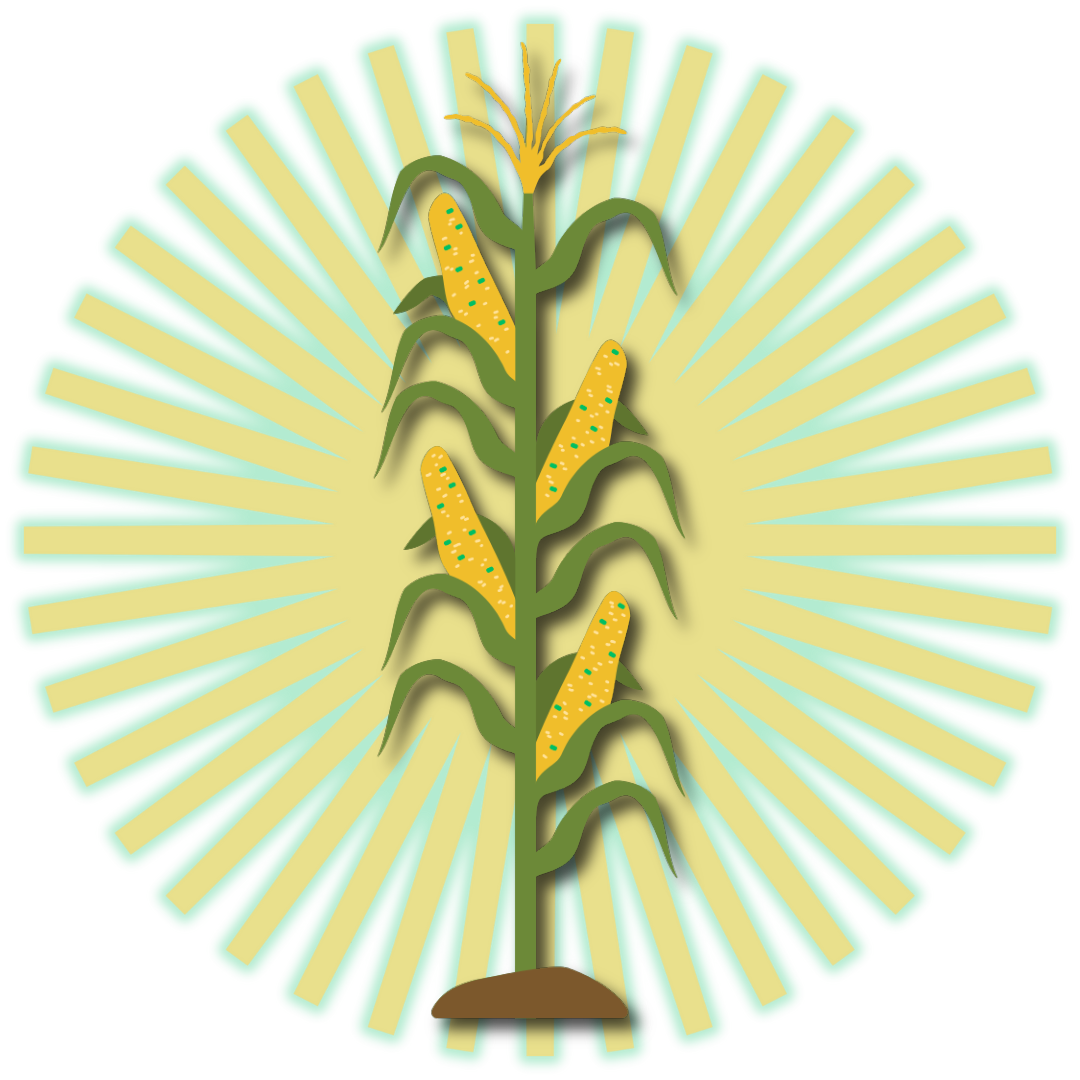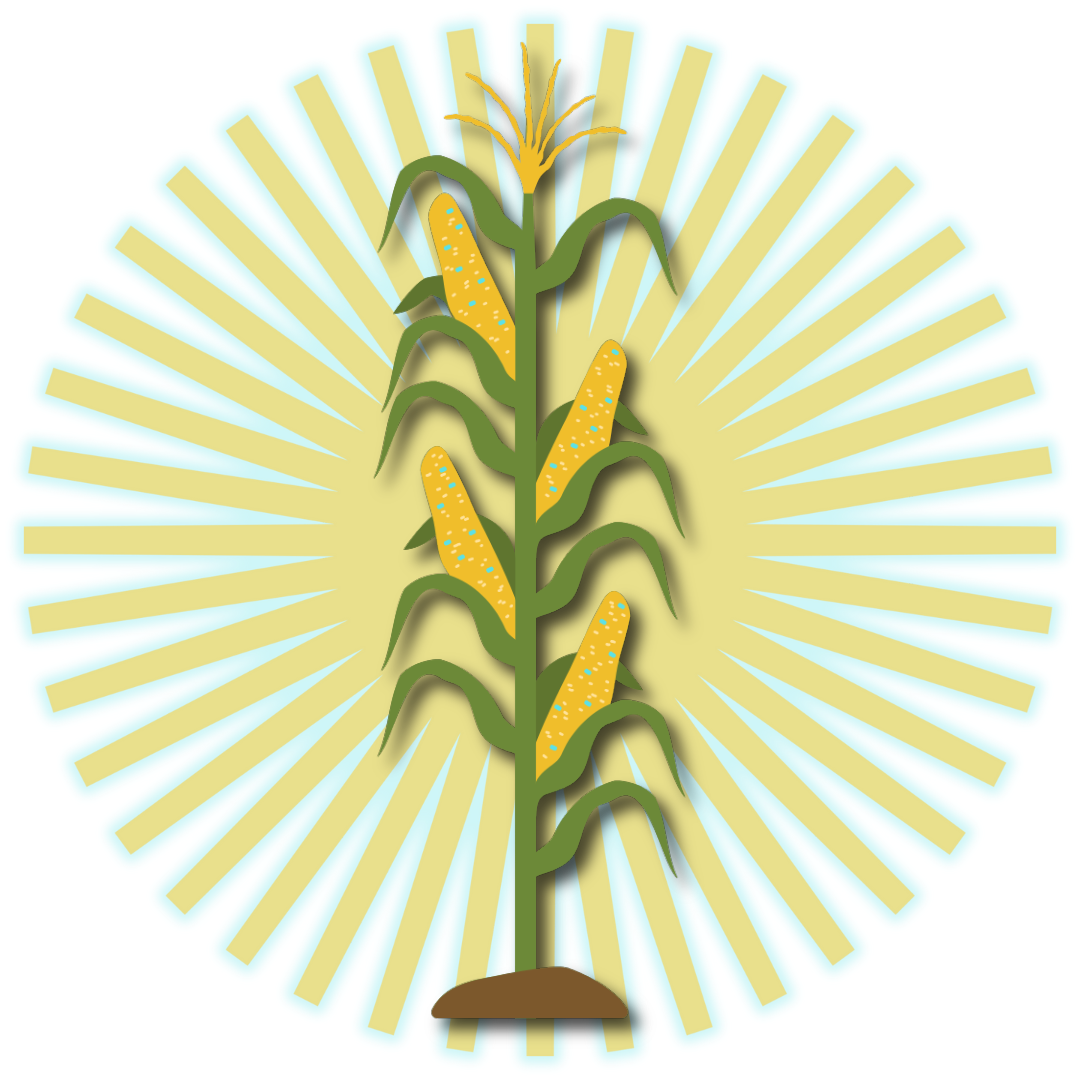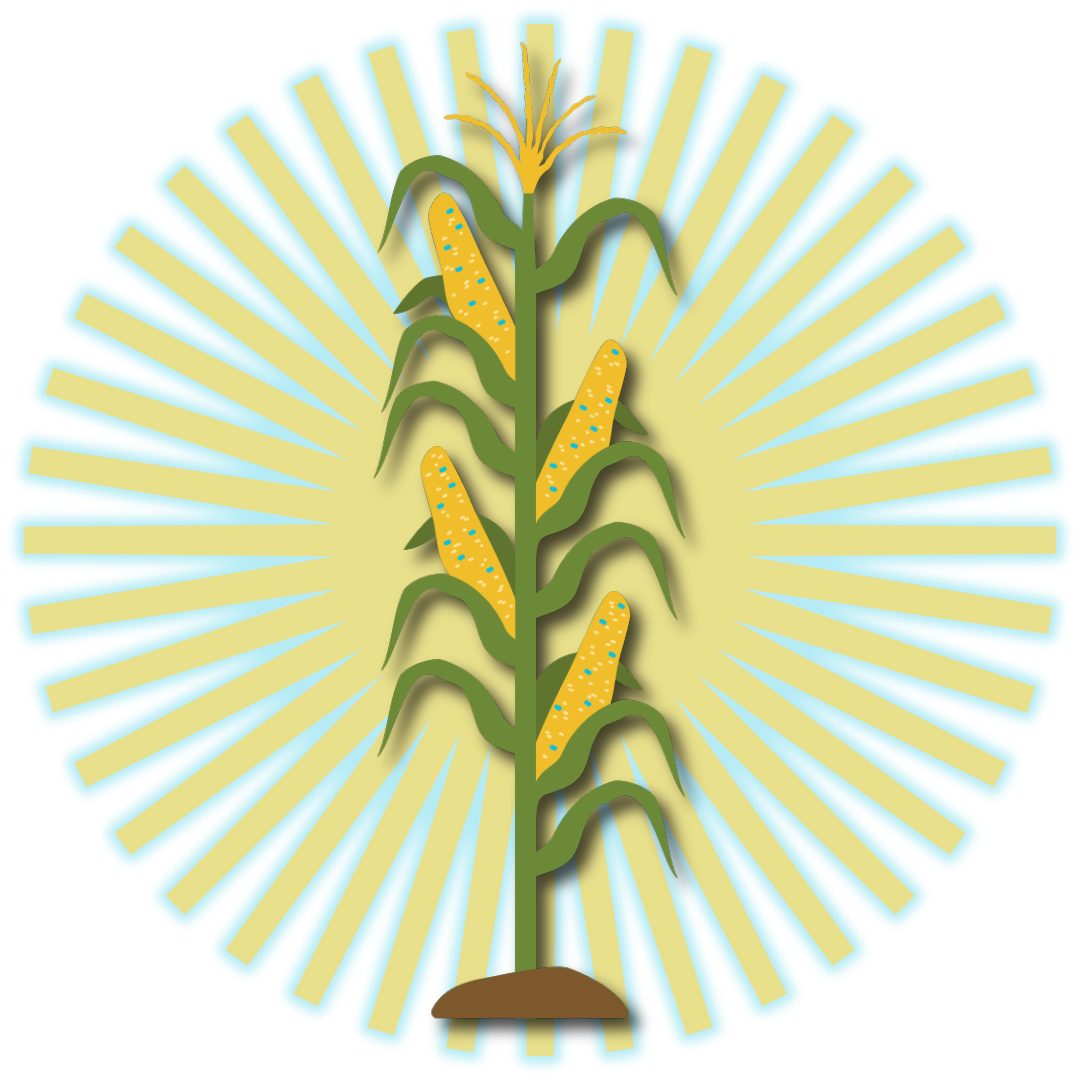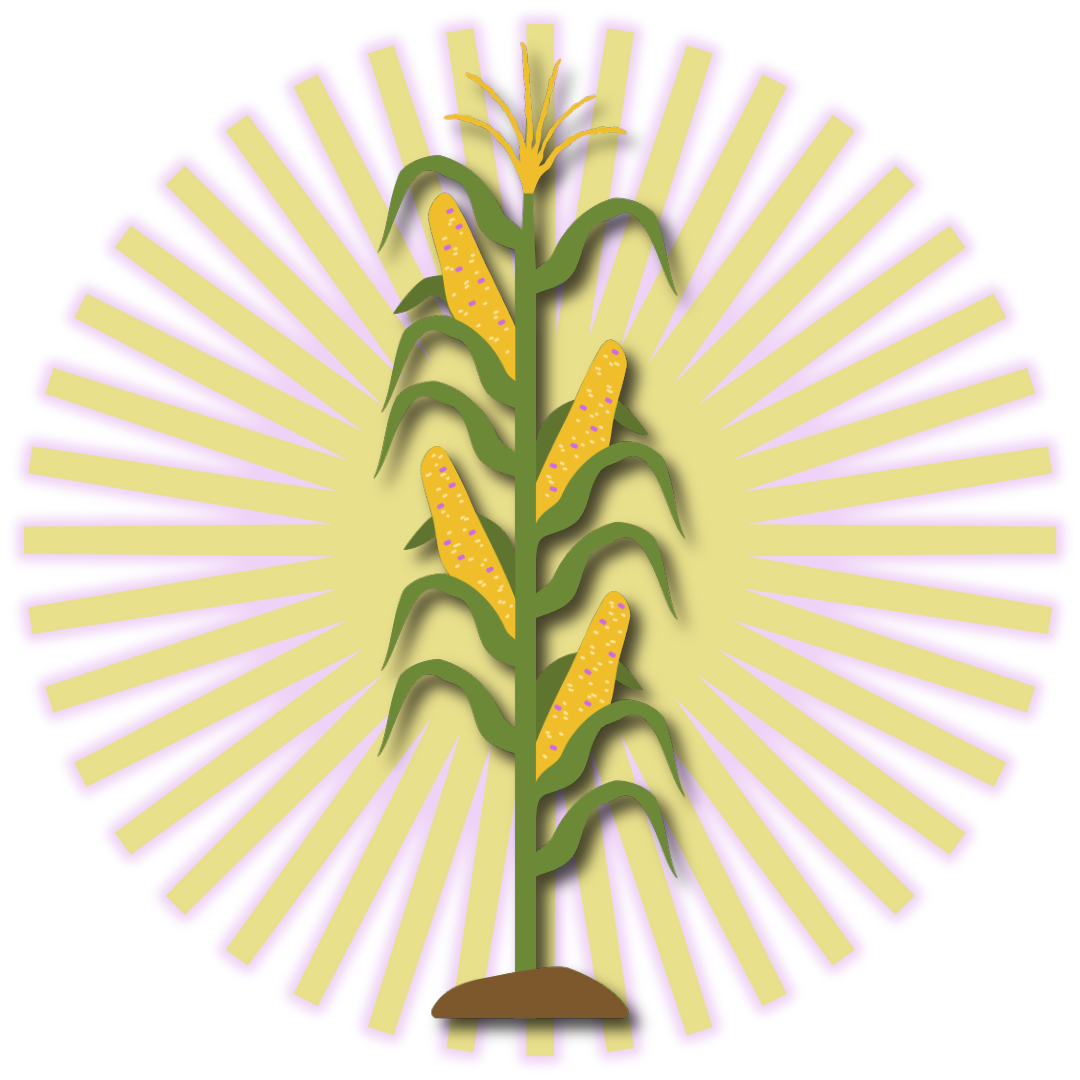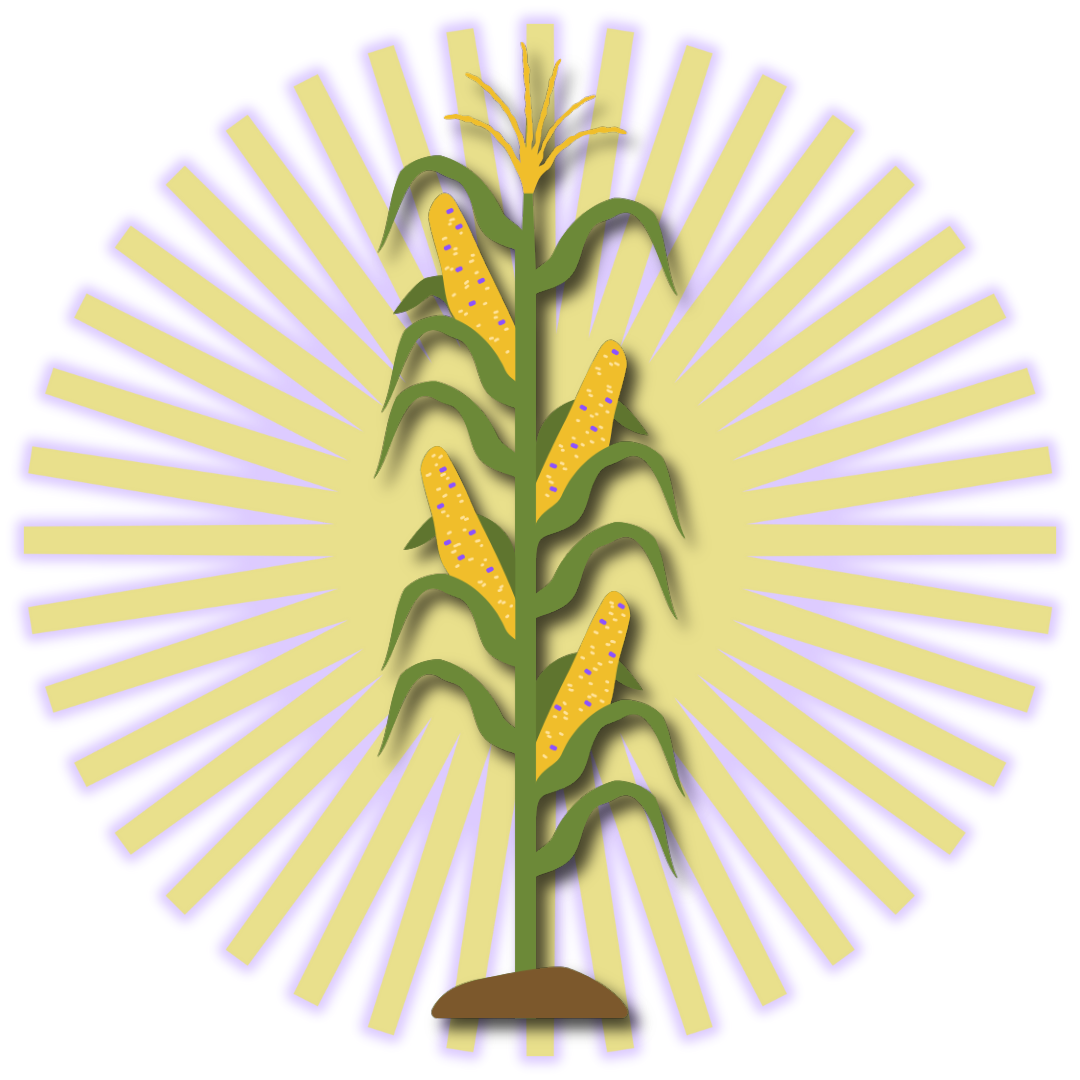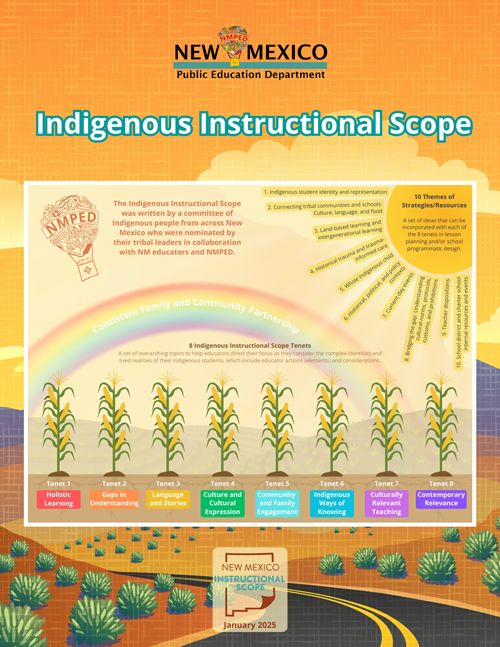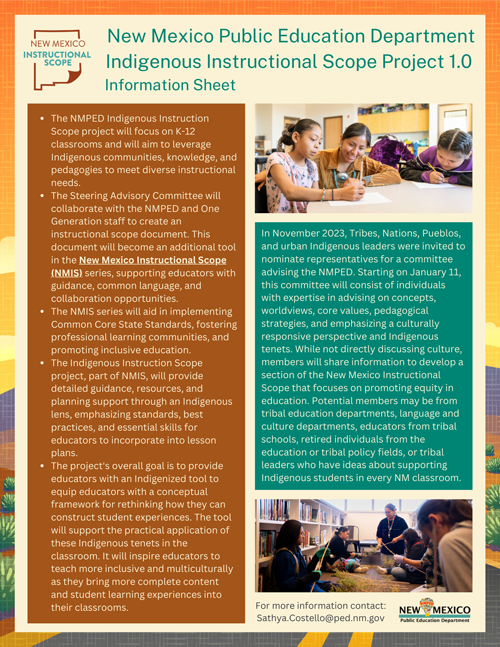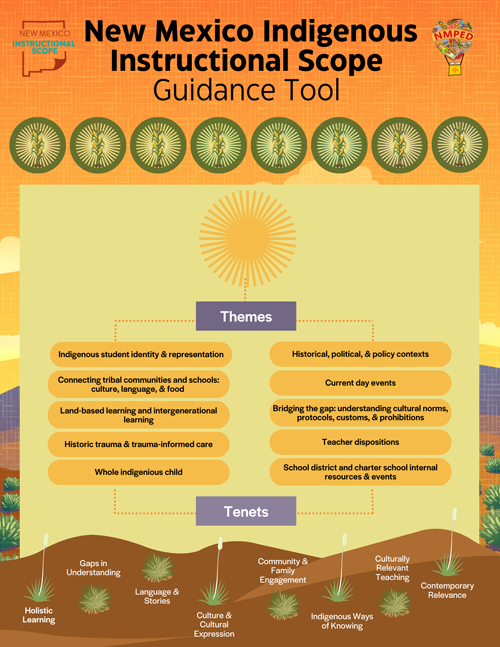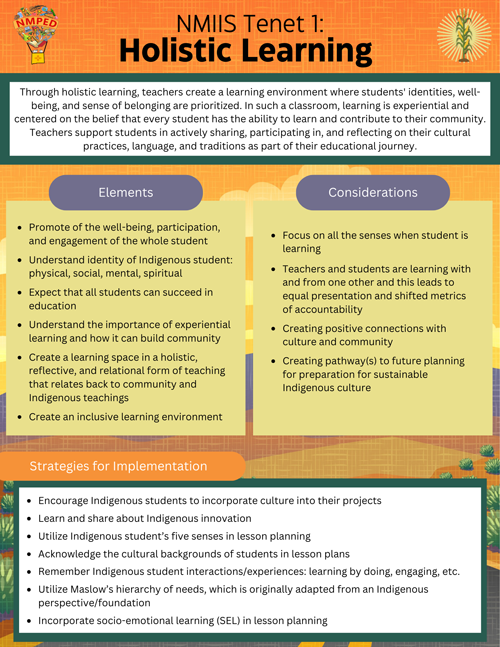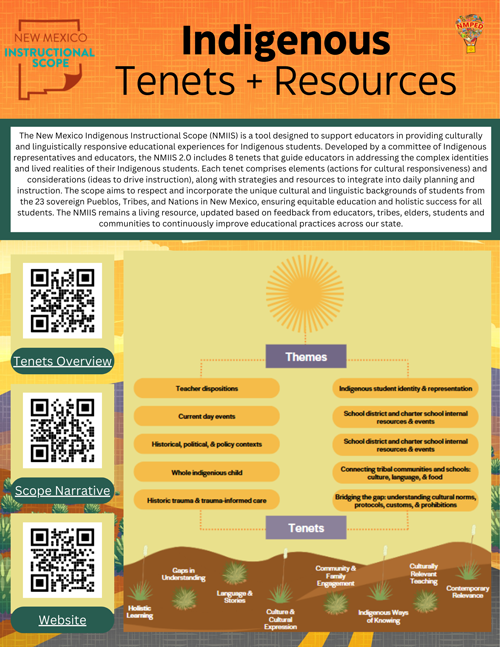Click on each tenet above to explore the definitions, elements, considerations, and resources for implementation.
Through holistic learning, teachers create a learning environment where students’ identities, well-being, and sense of belonging are prioritized. In such a classroom, learning is experiential and centered on the belief that every student has the ability to learn and contribute to their community. Teachers support students in actively sharing, participating in, and reflecting on their cultural practices, language, and traditions as part of their educational journey.
When I engage in holistic learning, my teacher and peers consider who I am, how I feel, and my role in the community, along with how my culture, language, and traditions connect to my learning to provide opportunities for all of us to succeed together.
ACTIONS THAT SHOULD BE TAKEN BY EDUCATORS TO ENSURE CULTURAL RESPONSIVENESS IN THEIR SCHOOLS AND CLASSROOMS
- Element 1: Promote of the well-being, participation, and engagement of the whole student
- Element 2: Understand identity of Indigenous student: physical, social, mental, spiritual
- Element 3: Expect that all students can succeed in education
- Element 4: Understand the importance of experiential learning and how it can build community
- Element 5: Create a learning space in a holistic, reflective, and relational form of teaching that relates back to community and Indigenous teachings
- Element 6: Create an inclusive learning environment
SPECIFIC IDEAS THAT NEED TO BE THOUGHT ABOUT WHEN PLANNING FOR INSTRUCTION AND ARE MEANT TO DRIVE ACTION
- Consideration 1: Focus on all the senses when student is learning
- How are all of the senses used by students in while they are learning?
- Consideration 2: Teachers and students are learning with and from one other and this leads to equal presentation and shifted metrics of accountability
- How do teachers and students learn from one another and share equal time and accountability in a classroom?
- Consideration 3: Creating positive connections with culture and community
- How are positive connections with culture and community created within and by the classroom?
- Consideration 4: Creating pathway(s) to future planning for preparation for sustainable Indigenous culture
- How can the classroom prepare for sustaining Indigenous culture?
CURATED BY THE INDIGENOUS SCOPE TRIBAL REPRESENTATIVES & NEW MEXICO EDUCATORS
- Encourage Indigenous students to incorporate culture into their projects
- Acknowledge cultural backgrounds of students in lesson plans
- Learn and share about Indigenous innovation
- Remember Indigenous student interactions and experiences learning by doing, engaging, etc.
- Utilize Maslow’s hierarchy of needs, which is originally adapted from an Indigenous perspective/foundation
- Utilize Indigenous students’ five senses in lesson planning
- Incorporate socio-emotional learning (SEL) in lesson planning
- IndigNMIdentity
- The Story of DEAP
- 5 Things to Know About Indigenous Knowledge When Working With Indigenous Children, Youth, and Families
- National Indian Education Association (NIEA) culturally-based curriculum
- IndigNM Cultural expressions
- Native American Heritage Month
- Native American Representation in STEM
- Developing a Robust Community Engagement Program
- Oral History Association
To address gaps in understanding, teachers will reflect on their own identities and privileges, as well as the effects of historical trauma, while striving to eliminate bias and assumptions from their teaching. They will stay open to ongoing learning, and actively seek out resources/training to understand the local indigenous nations and those represented in their classrooms.
When I recognize that everyone comes from different backgrounds, and understand these backgrounds offer unique learning opportunities and perspectives, I can value and celebrate the knowledge I possess and share it with others as we learn and build a community together.
ACTIONS THAT SHOULD BE TAKEN BY EDUCATORS TO ENSURE CULTURAL RESPONSIVENESS IN THEIR SCHOOLS AND CLASSROOMS
- Element 7: Examine their own identities and privileges
- Element 8: Understand historical trauma and colonialism and how it impacts Indigenous students
- Element 9: Collaborate with and participate in tribal preparation programs and professional development opportunities
SPECIFIC IDEAS THAT NEED TO BE THOUGHT ABOUT WHEN PLANNING FOR INSTRUCTION AND ARE MEANT TO DRIVE ACTION
- Consideration 5: Bias-free educational materials
- How should education be analyzed to determine bias and what should be done to mitigate bias in instructional materials?
- Consideration 6: Examine assumptions and pre-conceived notions
- What assumptions and pre-conceived notions underpin a teachers beliefs about their students and the communities they work in?
- Consideration 7: Reflect on power relationships in professional and teaching practice
- What are the power dynamics that underpin the educational system?
- Consideration 8: Identify educators’ limitations and reflect on areas for ongoing learning (flexibility and learning how to adjust for the educator)
- What are our limitations and how can we use reflection and ongoing learning to address these limitations?
- Consideration 9: Take time for reflection and deeper understanding of Indigenous students’ lived experiences
- How can taking time to reflect provide a deeper understanding of Indigenous students’ lived experiences?
- Consideration 10: Change dispositions of educators
- How can we change educator disposition to improve supports for Indigenous students?
- Consideration 11: School districts and charter schools should provide professional development and supports so that school leaders are knowledgeable about MOUs with school districts/charter schools and sovereign NM tribes, pueblos, and nations (and tribally-developed standards, if available)
- How are school districts and charters being intentional about collaborating with NM tribes, nations, and pueblos to create professional development to ensure educators are knowledgeable about MOUs between the school district/charter and the NM tribes, nations, and pueblos as well as tribally-developed standard (if available)?
CURATED BY THE INDIGENOUS SCOPE TRIBAL REPRESENTATIVES & NEW MEXICO EDUCATORS
- Acknowledge historical trauma and its impact on Indigenous students today
- Understand federal and state Indian policies (i.e. water rights, BLM land, relocation, etc.)
- Sense of humility when building understanding
- Creating an Indigenous-Centric Learning Environment
- New Mexico’s Unique Native American Communities
- Indian Pueblo Cultural Center
- Mescalero Apache Tribe
- Official Site of the Navajo Nation
- Jicarilla Apache Nation
- Ft. Sill Apache Tribe
- Jemez Tribe
- Resources for Teaching About Indigenous Peoples
- Institute of American Indian Research
Language and Stories emphasize the importance of integrating Indigenous languages and oral traditions in the classroom, valuing diverse languages, fostering respectful relationships, and connecting students with elders to enrich cultural connections and understanding of identity.
When I use or discuss the importance of my indigenous language, my community is validated and affirmed.
ACTIONS THAT SHOULD BE TAKEN BY EDUCATORS TO ENSURE CULTURAL RESPONSIVENESS IN THEIR SCHOOLS AND CLASSROOMS
- Element 10: Use oral traditions
- Element 11: Understand the diversity and validity of all tribal languages
- Element 12: Understand bilingual or multilingual students’ learning and communication (understanding, syntaxes, structures, meanings, and norms may be different in first language/primary language)
- Element 13: Create a space for students to use their tribal languages
- Element 14: Commit to revitalizing the local tribal language(s) and culture
SPECIFIC IDEAS THAT NEED TO BE THOUGHT ABOUT WHEN PLANNING FOR INSTRUCTION AND ARE MEANT TO DRIVE ACTION
- Consideration 12: Educational materials by Indigenous authors
- What educational materials are available that were authored/edited/created by Indigenous authors?
- Consideration 13: Reciprocal, respectful relationships
- How do we create and ensure reciprocal, respectful relationships among students, educators, and communities?
- Consideration 14: Connecting elders and knowledge keepers with students and educators
- How can educators connect Indigenous elders and knowledge keepers with students and classrooms?
- Consideration 15: Understanding the importance of acknowledging that Indigenous people may speak more than one tribal language
- Why is it important to acknowledge that some Indigenous people may speak more than one tribal language?
- Consideration 16: Encourage the use of tribal languages in student projects
- How can classrooms encourage the use of tribal languages in student projects?
CURATED BY THE INDIGENOUS SCOPE TRIBAL REPRESENTATIVES & NEW MEXICO EDUCATORS
- Invite elders and/or tribal members into the classroom oral storytelling, cooking, music, historical knowledge, art, pottery, etc.
- Encourage Indigenous students to incorporate culture into their projects
- Utilize Indigenous content written by Indigenous authors
- Remember that Tribes are open to questions and/or discussion with and/or from teachers
- Request tribal community tours with tribal education departments
Culture and Cultural Expression refers to the shared beliefs, values, customs, and practices that shape the identity of a group or community. Professional responsibility of teacher/educator to know who is in their classroom – not just that students are native american but by their tribe/nation/pueblo and have an awareness of their culture and traditions – an awareness of our students to be able to be culturally responsive.
When my culture is appreciated within the classroom, I am able to navigate what is appropriate to be shared and when it isn’t. To be open to learning about multiple cultures within my region.
ACTIONS THAT SHOULD BE TAKEN BY EDUCATORS TO ENSURE CULTURAL RESPONSIVENESS IN THEIR SCHOOLS AND CLASSROOMS
- Element 15: Recognize the complexity and diversity of Indigenous cultures (nonhomogeneous)
- Element 16: Understand Indigenous student identity
- Element 17: Understand their responsibility and accountability to community
- Element 18: Understand and foster Indigenous belonging
- Element 19: Understand cultural competency and awareness framework
SPECIFIC IDEAS THAT NEED TO BE THOUGHT ABOUT WHEN PLANNING FOR INSTRUCTION AND ARE MEANT TO DRIVE ACTION
- Consideration 17: Develop understanding of Indigenous students and the context they are coming from, i.e. tribal land, border town, urban setting, rural area, and/or close to border/across the border, etc.
- What are the contexts that Indigenous students might be coming from (ie: tribal land, border town, urban setting, rural area, and/or close to border/across the border, etc)?
- Consideration 18: Right to maintain, protect, and develop cultural heritage and traditional knowledge and when it can be shared
- How can educators ensure students’ right to maintain, protect, and develop cultural heritage and traditional knowledge and when it can be shared?
- Consideration 19: Indigenous histories, philosophies, epistemologies, theories, knowledges, worldviews, and cultures are well founded, sustainable, and valid
- How can educators show that Indigenous histories, philosophies, epistemologies, theories, knowledges, worldviews, and cultures are well founded, sustainable, and valid?
- Consideration 20: Understanding Indigenous students’ relationship to self, community, other living things, non-living things, the land, and the cosmos
- What is the impact of an Indigenous student’s relationship to self, community, other living things, non-living things, the land, and the cosmos?
- Consideration 21: Connection to ancestors and teachings that have been passed down through generations
- What impact do connections to ancestors and teachings that are passed down through the generations have on Indigenous students?
CURATED BY THE INDIGENOUS SCOPE TRIBAL REPRESENTATIVES & NEW MEXICO EDUCATORS
- Encourage Indigenous students to incorporate culture into their projects
- Encourage teachers to learn the tribal affiliation(s) of their students
- Acknowledge cultural backgrounds of students in lesson plans
- Request tribal community tours with tribal education departments
- Learn about Indigenous cultural calendars and/or feast days (Resource Indian Pueblo Cultural Center)
- Learn about traditional foods and utilize them in lesson planning
- Invitation to visit tribal community and/or feast day, followed by a reflection protocol/activity
- Highlight Indigenous excellence for students
- Understand tribal/cultural connections and prohibitions (i.e. eclipses, science and dissecting certain animals, field trips (*certain tribes have different protocols/prohibitions related to different animals, including owls, snakes, etc.) recommend teachers reach out to tribal education departments to inquire if the teachers’ students have prohibitions related to animals, etc.)
- Learn and share about tribal pageant representatives and how they can serve as role models for Indigenous students
- 5 Things to Know About Indigenous Knowledge When Working With Indigenous Children, Youth, and Families
- Ideas and Insights A Discussion on Decolonizing and Indigenizing Classrooms, Schools and Systems
- IndigNM Language
- IndigNM historical timeline
- IndigNM Urbanization
- New Mexico Native Tribes
- Indian Pueblo Cultural Center
- Nations, Pueblos and Tribes
Community and family engagement encourages continuous and consistent collaboration between school, families, and Indigenous communities to empower all students and to build relationships and partnerships while centering Indigenous knowledge in spaces of learning.
When I am supported by schools, families, and Indigenous communities who work together to build strong relationships, it centers my unique experiences and Indigenous knowledge into daily learning.
ACTIONS THAT SHOULD BE TAKEN BY EDUCATORS TO ENSURE CULTURAL RESPONSIVENESS IN THEIR SCHOOLS AND CLASSROOMS
- Element 20: Collaborate and work with elders
- Element 21: Engage with families on the establishment of mutually beneficial relationships
- Element 22: Understand service and giving back to community
- Element 23: Acknowledge only what is shared and credit appropriate sources
- Element 24: Understand urban Indigenous families and communities
SPECIFIC IDEAS THAT NEED TO BE THOUGHT ABOUT WHEN PLANNING FOR INSTRUCTION AND ARE MEANT TO DRIVE ACTION
- Consideration 22: Respect, trust, and positive relationships – bring the community into the classroom and go out into the community
- How can educators ensure respect, trust, and positive relationships by bringing the community into the classroom and by going out into the community?
- Consideration 23: Working in partnership with Indigenous parents to better meet their children’s needs
- How can educators working in partnership with Indigenous families to better meet their needs of their students?
- Consideration 24: Building a bridge between school and home
- How can educators build a bridge between school and home?
- Consideration 25: Understanding the role of families, clans, and tribal societies
- What role do family, clans, and tribal societies have in the lives of Indigenous students?
- Consideration 26: Engaging in intergenerational sharing and learning
- What impact does intergenerational learning and sharing have on Indigenous learning?
CURATED BY THE INDIGENOUS SCOPE TRIBAL REPRESENTATIVES & NEW MEXICO EDUCATORS
- Invite elders and/or tribal members into the classroom: oral storytelling, cooking, music, historical knowledge, art, pottery, etc.
- Invitation to collaborate and learn from families and community members about traditional foods and utilize them in lesson planning: tribal community, feast day, followed by a reflection activity
- Invite tribal leadership to present on lived experiences, professional experiences, and tribal sovereignty to promote authentic learning experiences
- Invite family and community partnerships, connect Indigenous students back to traditional knowledge and create opportunities to share with their school community
- Incorporate holistic approach to teaching by asking questions, be open to making mistakes, connect and/or partner with tribal educators.
- School district and charter school internal resources and events
Indigenous ways of knowing are holistic and relational understandings of the world that emphasize interconnectedness with nature, community, and ancestral knowledge. Nature is a teacher, offering wisdom through its cycles, patterns, and relationships, and highlight the reciprocal responsibility to care for the land and environment as stewards for future generations. These principles stress the importance of respecting and learning from elders, knowledge holders, and cultural leaders, who preserve and share the wisdom and traditions essential to sustaining communities and cultural identity.
When I understand that everything is connected and listen to the knowledge shared from elders and leaders about our strong traditions and communities, I can engage with the lessons that nature gives us and learn how to care for the land for future generations.
ACTIONS THAT SHOULD BE TAKEN BY EDUCATORS TO ENSURE CULTURAL RESPONSIVENESS IN THEIR SCHOOLS AND CLASSROOMS
- Element 25: Understand nature is a teacher
- Element 26: Understand responsibility to take care of the land/environment
- Element 27: Honor the elders, knowledge holders, and cultural leaders
SPECIFIC IDEAS THAT NEED TO BE THOUGHT ABOUT WHEN PLANNING FOR INSTRUCTION AND ARE MEANT TO DRIVE ACTION
- Consideration 27: Indigenous ways of knowing are valid
- How can educators ensure Indigenous ways of knowing in regards to nature are shown to be valid?
- Consideration 28: Acknowledge, value, and honor Indigenous excellence
- How can we acknowledge, value, and honor Indigenous excellence?
- Consideration 29: Recognize and build upon the interrelationships that exist among the natural, human, and spiritual realms in the world around the Indigenous students
- How can educators recognize and build upon the interrelationships that exist among the natural, human, and spiritual realms in the world of the Indigenous students?
CURATED BY THE INDIGENOUS SCOPE TRIBAL REPRESENTATIVES & NEW MEXICO EDUCATORS
- Create an outdoor learning space/opportunity that reflects community values and knowledge.
- Understand and make space for students’ cultural and/or ceremonial obligations/events
- Invite elders and/or tribal members into the classroom: oral storytelling, cooking, music, historical knowledge, art, pottery, etc.
- Land-based learning and intergenerational learning
- Encourage Indigenous students to incorporate culture into their projects
- Learn about Indigenous cultural calendars and/or feast days
- Remember that Tribes are open to questions and/or discussion with and/or from teachers
- Utilize Indigenous students’ five senses in lesson planning
- Utilize local resources and local expertise
- Understand students’ cultural and/or ceremonial obligations/events
- Understand federal and state Indian policies (i.e. water rights, BLM land, relocation, etc.)
- Bridging the gap: understanding cultural norms, protocols, customs, and prohibitions
- Cultural Learning Circles
- Traditional Ecological Knowledge
- The Story of DEAP
- 5 Things to Know About Indigenous Knowledge When Working With Indigenous Children, Youth, and Families
- National Indian Education Association (NIEA) culturally-based curriculum
- IndigNM historical timeline
- IndigNM Cultural expressions
Culturally relevant teaching is an awareness of the cultural norms of students in the classroom and intentionally elevating relevancy to create lesson plans reflective of their culture(s).
When I am provided with instruction that is relevant to my culture, language, and identity, I have a deeper capacity and dedication to learn alongside my peers
ACTIONS THAT SHOULD BE TAKEN BY EDUCATORS TO ENSURE CULTURAL RESPONSIVENESS IN THEIR SCHOOLS AND CLASSROOMS
- Element 28: Acknowledge appropriate and accurate tribal information that is approved and can be shared publicly
- Element 29: Understand Indigenous equity and inclusion
- Element 30: Understand a set of foundational principles and understandings that guide the continued development and engagement of instructional practices that inform pedagogical approaches
- Element 31: Assure that Indigenous students can see themselves in the curriculum and lesson planning
- Element 32: Understand how to approach the community in a respectful and appropriate manner
SPECIFIC IDEAS THAT NEED TO BE THOUGHT ABOUT WHEN PLANNING FOR INSTRUCTION AND ARE MEANT TO DRIVE ACTION
- Consideration 30: Create ways to nurture cultural safety in educators’ classrooms
- How can educators create ways to nurture cultural safety in educators’ classrooms?
- Consideration 31: Critically question oversimplifications and overgeneralizations about Indigenous peoples and Indigenous knowledge
- How can educators critically question oversimplifications and overgeneralizations about Indigenous peoples and Indigenous knowledges?
- Consideration 32: Awareness of cultural norms
- How can educators become better aware of Indigenous cultural norms?
- Consideration 33: Inclusion of cultural aspects in the different subjects – relevant by combining both past and current history and knowledge
- How can educators ensure the inclusion of cultural aspects in difference subjects by combining past and current histories and knowledges?
- Consideration 34: Alignment of teaching and instructions to their Indigenous students’ community-based core values, philosophy, identity, and place
- How can educators align teaching and instructions to their Indigenous students’ community-based core values, philosophy, identity, and place?
CURATED BY THE INDIGENOUS SCOPE TRIBAL REPRESENTATIVES & NEW MEXICO EDUCATORS
- Encourage teachers to learn the tribal affiliation(s) of their students
- Utilize Indigenous content written by Indigenous authors
- Request tribal community tours with tribal education departments
- Invitation to visit tribal community and/or feast day, followed by a reflection protocol/activity
- Utilize land-based learning and curriculum
- Incorporate gardening (seeds, planting, harvesting) into lesson planning
- Understand the importance of intergenerational learning and utilize model if possible
- Utilize Indigenous students’ five senses in lesson planning
- Utilize gradual release of responsibility model (model of teaching that provides a structured framework for releasing the responsibility from teacher to the student)
- Understand tribal historical context
- Understand tribal/cultural connections and prohibitions (i.e. eclipses, science and dissecting certain animals, field trips (*certain tribes have different protocols/prohibitions related to different animals, including owls, snakes, etc.) recommend teachers reach out to tribal education departments to inquire if the teachers’ students have prohibitions related to animals, etc.)
- Utilize local resources and local expertise
- Utilization of relational skills in building authentic connections
- School district and charter school land acknowledgements
Contemporary relevance in instruction consists of lessons that intentionally align Indigenous cultural history and its connection to present-day events, allowing us to learn from the past to navigate any current and future challenges to inform our decision-making today.
When I study historical events and reference my lived experiences, I can trace the origins of present-day conflicts, social movements, economic systems, and political ideologies, to gain a better understanding and connect the history of my culture to current events and describe how they are equally important.
ACTIONS THAT SHOULD BE TAKEN BY EDUCATORS TO ENSURE CULTURAL RESPONSIVENESS IN THEIR SCHOOLS AND CLASSROOMS
- Element 33: Highlight that Indigenous culture is alive today
- Element 34: Acknowledge current representations
- Element 35: Understand privilege, bias, omission, and misrepresentation
- Element 36: Respect of tribal sovereignty
- Element 37: Understand connection with federal Indian policies
- Element 38: Understand the complexities of being a modern Indigenous person and the continuation of culture and traditions while living in the current time/space
SPECIFIC IDEAS THAT NEED TO BE THOUGHT ABOUT WHEN PLANNING FOR INSTRUCTION AND ARE MEANT TO DRIVE ACTION
- Consideration 35: Understanding the historical context of Indigenous tribes and how it impacts their students today
- How can educators understand the historical context of Indigenous tribes and how it impacts students today?
- Consideration 36: Indigenous students are unique and diverse and have different language, cultural, and traditional lifeways
- How do the unique and diverse language, culture, and traditional lifeways of Indigenous students impact them?
- Consideration 37: Empowering students to find and use their voices
- How can educators empower Indigenous students to find and use their voice?
- Consideration 38: Understanding the cultural/traditional responsibilities of the Indigenous students
- What are the cultural/traditional responsibilities of Indigenous students?
- Consideration 39: Proactive lesson planning based on the Indigenous students in the educators’ classrooms
- How can educators proactively lesson plan based on the Indigenous students in the educator’s classroom?
- Consideration 40: Understanding that Indigenous students can be multicultural (including multiple tribes and/or multiple ethnicities) and/or multilingual (speak Indigenous languages and non-Indigenous languages)
- What impact do Indigenous students’ potential multicultural (including multiple tribes and/or multiple ethnicities) and/or multilingual (speak Indigenous languages and non-Indigenous languages) have in the classroom?
CURATED BY THE INDIGENOUS SCOPE TRIBAL REPRESENTATIVES & NEW MEXICO EDUCATORS
- Invite Tribal programs (i.e. Behavioral Health, BIA Staff, CHR program)
- Encourage Indigenous students to incorporate culture into their projects
- Acknowledge the cultural backgrounds of students in lesson plans
- Connect with Indigenous students’ guardians/caretakers/parents
- Utilize Indigenous content created by Indigenous authors
- Take the time to learn about Tribal/Pueblo customs and their relation to the natural world
- Understand and learn about the New Mexico Legislature and impacts Indigenous Peoples
- Acknowledge historical trauma and its impact on Indigenous students today
- Understand students’ cultural and/or ceremonial obligations/events
- Highlight Indigenous excellence for students
- Spirit of the Trees (Northwest Tribes)
- Ancestral Homelands of the Jicarilla Apache
- Grounded in Clay: The Spirit of Pueblo Pottery
- Zuni Schools Profile of a Graduate
- What do Decolonization and Indigenization Look Like in the Classroom?
- How Do You Save an Endangered Language?
- Federal Indian Boarding School Initiative Investigative Report
- IndigNM Identity
- 5 Things to Know About Indigenous Knowledge When Working With Indigenous Children, Youth, and Families
- What is white fragility, and why is it a problem?
- Ideas and Insights A Discussion on Decolonizing and Indigenizing Classrooms, Schools and Systems
- National Indian Education Association (NIEA) culturally-based curriculum
- What is Trauma-Informed Care?
- Tribal TTA Center Healing-Informed Care
- Trauma-informed Caring for Native American Patients and Communities
- Ticking the box of ‘cultural safety’ is not enough
- Trauma and Resilience in Native Communities
- Trauma and Resilience Resources
- Coolangatta Statement on Indigenous Rights in Education
The New Mexico Indigenous Instructional Scope is designed to support educators in being intentional in their lesson planning and programmatic planning while taking specific considerations into account that may impact indigenous students and communities. It is intended to be a tool to support all educators as they provide high-quality culturally responsive educational experiences across New Mexico. The NM Indigenous Instructional Scope includes a set of tenets comprised of elements and considerations, that, when combined, provide encouragement and inspiration to support the creation of learning environments which incorporate culturally and locally aligned supports for indigenous students from the 23 sovereign Pueblos, Tribes, and Nations across NM.
In consideration of the importance of the cultural and linguistic diversity of our learners, the creation of this tool, written by a committee of indigenous people from across NM who were nominated by their tribal leaders, is intended to provide a resource that guides educators in considering and incorporating the rich backgrounds of students at the local level. The Scope is not curriculum. Rather, the NM Indigenous Instructional Scope is a tool that can be used alongside the other NM Instructional Scopes Scopes (Language Arts, Spanish Language Arts, Mathematics, Science, and Social Studies, click here for NM Instructional Scopes Homepage) and is intended to help assure that all students have access to culturally and linguistically responsive instruction that respects students. This tool also seeks to help educators understand the importance of indigenous identity, with suggestions for how and when to incorporate the rich backgrounds of NM students within the school and classroom environments.
What is included in the Indigenous Instructional Scope:
- 8 Tenets: a set of overarching topics to help educators direct their focus as they consider the complex identities and lived realities of their indigenous students. Each tenet includes the following nested information:
- Elements are actions that should be taken by educators to ensure cultural responsiveness in their schools and classrooms.
- Considerations are specific ideas that need to be thought about when planning for instruction and are meant to drive action.
- 10 Themes of Strategies/Resources: a set of ideas that can be incorporated with each of the 8 tenets in lesson planning and/or school programmatic design.
You are encouraged to read the Indigenous Instructional Scope in its entirety.
Should you need support, please contact Sunni Costello (sathya.costello@ped.nm.gov) with the Curriculum and Instruction Bureau.
STEERING COMMITTEE: REPRESENTATIVES FROM NEW MEXICO PUEBLOS, TRIBES, AND NATIONS
AILEEN LOPEZ, OHKAY OWINGEH
DR. ANDY NEZ, NAVAJO NATION
ANPAO DUTA FLYING EARTH, INDIAN EDUCATION ADVISORY COMMITTEE MEMBER
BETTINA SANDOVAL, TAOS PUEBLO
CARLY JO CHAVARRIA, SANTA CLARA PUEBLO
CASSANDRA SALAZAR, NAMBE PUEBLO
CRISTAL SUAZO, POJOAQUE PUEBLO
DR. JOHN GATES, ALBUQUERQUE PUBLIC SCHOOLS
JUAN MONTOYA, SANTA ANA PUEBLO
JULIE WEIGAND, PICURIS PUEBLO
KIMBERLY ZAH, AZTEC MUNICIPAL SCHOOLS
LEON HERRERA, TESUQUE PUEBLO
LESLIE VALLO, ACOMA PUEBLO
MARSHA LENO, ZIA PUEBLO
NANCY DAVIS ROYBAL, SANTA FE PUBLIC SCHOOLS
DR. REYNELLE LOWSAYATEE, ZUNI PUEBLO
RUTHIE CHAVEZ, SAN FELIPE PUEBLO
STEPHANIE MACK, JEMEZ PUEBLO
TIRZAH TOYA-WACONDA, NATIVE AMERICAN COMMUNITY ACADEMY
VIRGIL SIOW, LAGUNA PUEBLO
EDUCATOR WORKING GROUP: NEW MEXICO DISTRICT AND CHARTER EDUCATOR REPRESENTATIVES
ALEIA J. AGUILAR (SANTO DOMINGO PUEBLO), BERNALILLO PUBLIC SCHOOLS
ALEXANDRA BLOSSOM, SANTA FE PUBLIC SCHOOLS
AMY ERICKSON ED.S MS CCC-SLP, NCES DISTRICT
ANNE MCGOVERN, SANTA FE PUBLIC SCHOOLS
DR. BERLINDA BEGAY (DINÉ), CENTRAL CONSOLIDATED SCHOOL DISTRICT
CASSANDRA BROWN, AZTEC MUNICIPAL SCHOOL DISTRICT
DR. ERICSON MACAPUNO, BERNALILLO PUBLIC SCHOOLS
FLORENCE ACQUE (ZUNI PUEBLO), ZUNI PUBLIC SCHOOL DISTRICT
FRANCINE BINNERT, COTTONWOOD CLASSICAL PREPARATORY SCHOOL
DR. GERALDINE GARRITY (DINÉ), FARMINGTON MUNICIPAL SCHOOLS
HARRIET CHAVEZ (PUEBLOS OF COCHITI AND KEWA), SANTA FE PUBLIC SCHOOLS
JENESSA GARCIA, BERNALILLO PUBLIC SCHOOLS
JOLENE E. VIGIL (PUEBLOS OF POJOAQUE AND NAMBE), SANTA FE PUBLIC SCHOOLS
DR. JORDAN SANER, BERNALILLO PUBLIC SCHOOLS
LOUISE RAMONE (DINÉ), FARMINGTON MUNICIPAL SCHOOLS
LULA BEGAY (DINÉ), FARMINGTON MUNICIPAL SCHOOLS
NADINE M. CHATTO (DINÉ AND APACHE), DREAM DINE’ CHARTER SCHOOL
DR. NICKY MENDOZA (CHICANA, MEXICA-AZTECA, ISLETA PUEBLO), LOS LUNAS PUBLIC SCHOOLS
ROSE MARIE A. LOPEZ (CHIHENE NDÉ NATION OF NM; GILA & MIMBRENO APACHE), LAS CRUCES PUBLIC SCHOOLS
SAMANTHA HERRERA (TAMAYA; SANTA ANA PUEBLO), BERNALILLO PUBLIC SCHOOLS
SARA AMES BROWN, RUIDOSO MUNICIPAL SCHOOLS
SUE HOLLAND, RATON PUBLIC SCHOOLS
TATÉ WÁŠTE WÍŊYAŊ (GOOD WIND WOMAN) (OČHÉTHI ŠAKÓWIŊ TATÁŊKA OYÁTE; BUFFALO NATION), NCES DISTRI
TISH HOWARD (PUEBLO OF ISLETA), LOS LUNAS PUBLIC SCHOOLS
DR. VALERIE GRIMLEY (PUEBLO OF COCHITI AND DINÉ), SANTA FE INDIAN SCHOOL
VERNA CALABAZA (SANTO DOMINGO PUEBLO), BERNALILLO PUBLIC SCHOOLS

